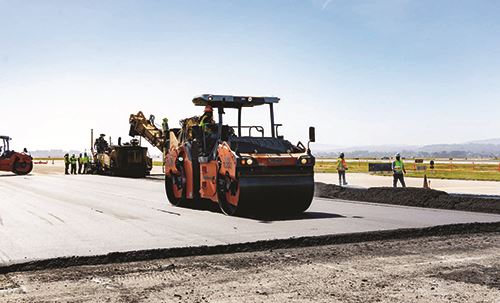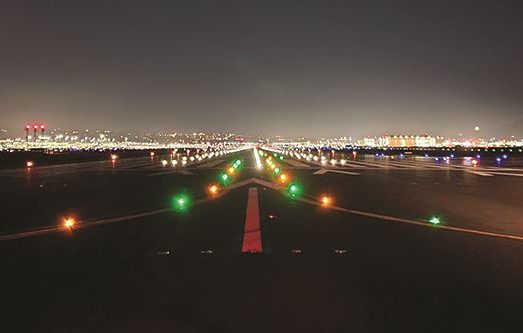Earlier this year, San Francisco International Airport (SFO) revealed plans to repave its shortest runway, 1L-19R, with new asphalt. That’s not unusual, because the airport regularly performs minor routine maintenance on its four runways combined with a full repaving every 10 to 12 years based on usage.
Earlier this year, San Francisco International Airport (SFO) revealed plans to repave its shortest runway, 1L-19R, with new asphalt. That’s not unusual, because the airport regularly performs minor routine maintenance on its four runways combined with a full repaving every 10 to 12 years based on usage. It was simply 1L-19R’s turn in the rotation. The unusual part is that this time, the airport was planning to complete the work in eight short weeks.
That meant crews had just over two months to repave the equivalent of 23 football fields, lay more than six miles of electrical cabling, install nearly 300 light fixtures and stripe the runway with 1,000 gallons of paint. The compressed timeline was dependent on dry weather and less airfield traffic, so the airport team and its project partners scheduled work between the hectic winter holidays and busy summer travel season.
It was difficult to find an easy time, as SFO is a major hub for United and Alaska Airlines, and home to more than 45 other carriers. Its four runways and four terminals are once again buzzing with activity as the airport recovers from historic passenger lows caused by COVID-19. In late August, SFO was on track to have its busiest summer since the pandemic began, and officials expect to serve a total of 46 million passengers by the end of this year. For reference, annual passenger volume dropped from 57.48 million in 2019 to 16.42 million during the pandemic-plagued 2020. From all indications, SFO is well on its way back—especially during the summer tourist season.
|
Project: Runway Rehabilitation Location: San Francisco Int’l Airport Runway: 1L-19R (7,650 ft. long, 200 ft. wide) Project Scope: Overlaying runway with new asphalt; replacing incandescent lights with LEDs; unplanned pavement improvements to adjacent taxiway Cost: $48.5 million Funding: $27.9 million from FAA grant; $20.6 million from airport Timeline: Design completed in early 2022; construction contract awarded in Oct. 2022; preconstruction Oct. 2022-Feb. 2023; construction March 2023-May 22, 2023 Materials: 1,700 truckloads of asphalt; 6.25 miles of electrical cabling; 350 light fixtures; 1,000 gallons of paint for runway markings Project Management: AECOM General Contractor: Golden Gate Constructors Lighting Subcontractor: Royal Electric Co. Lighting Mfg: ADB SAFEGATE Key Benefits: Smoother pavement surface; safer takeoffs & landings; less energy & maintenance required for new LEDs |
With that kind of passenger volume, taking a runway out of service for maintenance requires predictive analysis and precise execution. The Runway 1L-19R project was launched in 2021, and the design completed in early 2022. Preconstruction activities took place between October 2022 and February 2023, and the runway closed on March 27, 2023, so construction could begin. In the end, 1L-19R reopened on May 22, 2023, a few days ahead of schedule.
“A lot of our runway projects start two to three years before we’re ready to begin construction,” says SFO Project Manager Daniel Lee. “We phased runway work so we would have certain areas of the taxiways available to allow aircraft to cross, and that reduces departure delays.”
Knowing there would be little cushion in the schedule, the airport hired AECOM to manage the project. The team divided work into four phases, each with multiple layers of construction and associated coordination. AECOM Project Manager Audrey Brook worked closely with the airport’s Airside Operations Department and the contractor to create work plans three weeks out at a time.
“Partnering with the team is key,” Brook says. “In a project like this with a compressed schedule, we don’t want to compromise the quality to finish on time. Building up trust and being responsible for each other’s success and challenges is important. All these little things that intertwine can be difficult at times, but we understood that we are working together.”
In addition to milling and overlay work, the project addresses the geometry of adjoining taxiways. Engineers also widened and reconstructed adjacent taxiways. Overall, the infrastructure improvements cost $48.5 million, and $27.9 million was funded with portions of a federal Airport Improvement Program grant.
Beyond the 1,700 truckloads of paving materials needed for the project, updated lighting fixtures and associated electrical components were a significant part of the budget.
New LED Fixtures
Golden Gate Constructors, a joint venture between DeSilva Gates Construction and Graniterock, was general contractor for the project, and it tapped Royal Electric Company for the lighting portion. Having worked at SFO for a dozen years, Royal was already familiar with the airport’s preferred process for installing ductwork, conduit and light fixtures.
 “The project was very, very tight, with an aggressive schedule,” says Lakshmi Bandaru, senior project manager for Royal Electric Company. “We had been pre-planning at least six months in advance and had less than seven weeks for a complete turnaround.”
“The project was very, very tight, with an aggressive schedule,” says Lakshmi Bandaru, senior project manager for Royal Electric Company. “We had been pre-planning at least six months in advance and had less than seven weeks for a complete turnaround.”
The company turned to ADB SAFEGATE for new light fixtures in short order. Due to the existing strong relationship between the two companies, the needed lights were ready on time. Hundreds of LED light fixtures, plus additional runway signage, were manufactured in four weeks.
“Usually, ‘really quick’ means about a month, so this was really, really quick,” says Jim Taylor, Western Region sales director for ADB SAFEGATE.
The company installed its new Axon lights, which have a reinforced top cover design with backwards compatibility to numerous ADB legacy inset fixtures. The fixtures also feature “bullnose” protection of the prism window to minimize damage from aircraft and snowplows. These same fixtures offer an optional sensor package to utilize ADB’s Linc360 power line carrier method to monitor the real-time health and status of the fixture.
 “They’re not simply a light in a special housing, but a smarter fixture that can provide feedback to the airport,” says Taylor.
“They’re not simply a light in a special housing, but a smarter fixture that can provide feedback to the airport,” says Taylor.
The new LED fixtures replace incandescent runway lights that required more energy and labor hours for maintenance. Airport leaders look forward to reaping the associated benefits.
As soon as the new lights were available from ADB SAFEGATE’s plant in Columbus, OH, it was an all-hands-on-deck situation. Crews from Royal Electric installed all 350 runway and taxiway lights, 20 airfield signs and wind cones in just seven days. Bandaru notes that it typically takes a week or two for engineers to respond to questions from the field. In this case, answers were immediate and on target. They had to be, she adds.
Weather and Other Challenges
As with any outdoor project, weather was a bit of a wild card during the Runway 1L-19R rehab. But the stakes were extra high given its short timeline. Rain postponed paving operations for a few days, but SFO had an ace up its sleeve for such circumstances.
 “The airport reopened the adjacent runway to allow planes to land in a north-south direction,” Brook explains. “We played catch-up once the weather cleared.”
“The airport reopened the adjacent runway to allow planes to land in a north-south direction,” Brook explains. “We played catch-up once the weather cleared.”
Catching up wasn’t always a straightforward process. The team had to ensure that downstream activities and materials weren’t adversely affected, as well as notify stakeholders about adjustments to the timeline. Delays were nerve-wracking for Brook and other project leaders. “When AECOM sets a goal for a runway project, it’s a promise,” she remarks.
Another challenge emerged on an adjacent taxiway. Forensic core samples of work completed in the 1980s indicated that some areas of the concrete were in poor condition, so crews had to rebuild them. Golden Gate Construction kept the project on schedule by demolishing the problematic pavement and re-compacting and treating the subgrade in three to four days.
“Much of the taxiway structure is built with crushed aggregate with treated base and asphalt on top of that,” explains Lee. “For this particular project, we used a pavement structure.”
Brook emphasizes that even with unforeseen problems and an aggressive schedule, the team never compromised quality to finish on time. Instead, contractors scheduled crews day and night to maximize their available airfield time. They also used Bluebeam construction software to keep inspectors informed about the status of various project elements so they could brief and mobilize the next shift.

Silence Speaks Volumes
Crews finished the $48.5 million project just before Memorial Day, with three days to spare before the May 25 target date. The airport is pleased with both the outcome and the speed at which it was delivered, Lee notes.
 “Passengers will notice there are fewer cracks and a smoother landing,” he adds. “Now, it’s more durable. The specs for every project we’ve had over the years and the quality of the material improves. With the new lighting fixtures, pilots can feel safer and be able to see the runway clearly, which is ultimately our job; we update the runways to be the most FAA-compliant.”
“Passengers will notice there are fewer cracks and a smoother landing,” he adds. “Now, it’s more durable. The specs for every project we’ve had over the years and the quality of the material improves. With the new lighting fixtures, pilots can feel safer and be able to see the runway clearly, which is ultimately our job; we update the runways to be the most FAA-compliant.”
Another success noted was reducing potential flight delays and cancellations. Daily calls with the air traffic control tower advised FAA personnel if a certain area of work might involve more taxiway closures or outages. The protocols the airport team built encouraged cooperation that enhanced safety for all onsite crews, notes Lee.
“Although we closed down two runways [1R-19L and 1L-19R], we did it with very little disruption,” he reflects. “We didn’t raise any eyebrows or trend on social media. We were able to complete such a major project almost in silence.”


 facts&figures
facts&figures

